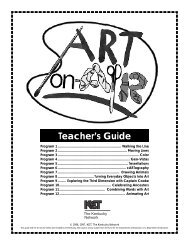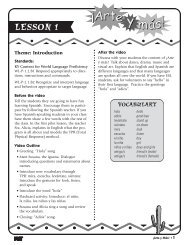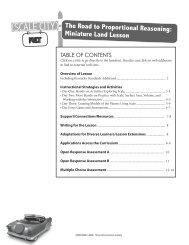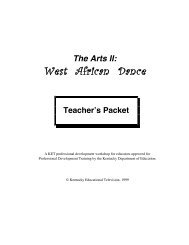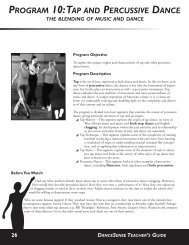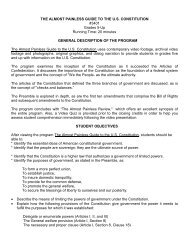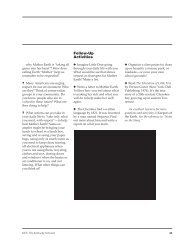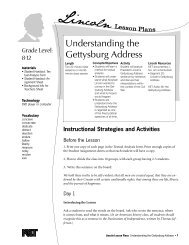7369 old music 2402 - KET
7369 old music 2402 - KET
7369 old music 2402 - KET
You also want an ePaper? Increase the reach of your titles
YUMPU automatically turns print PDFs into web optimized ePapers that Google loves.
An Historical<br />
and Musical<br />
Background<br />
on the<br />
Appalachian<br />
Region<br />
Editor’s Note: Mike<br />
Seeger, who performs in<br />
several programs, prepared this<br />
essay to give teachers some<br />
background on one type of<br />
<strong>music</strong> featured throughout Old<br />
Music for New Ears.<br />
© 1984, Mike Seeger;<br />
reprinted with permission.<br />
I play and sing traditional mountain<br />
<strong>music</strong>, mostly of the Appalachian<br />
mountain region, from Virginia and<br />
West Virginia southward through<br />
eastern Kentucky, eastern Tennessee,<br />
and the Carolinas and on into Georgia<br />
and Alabama. Roughly speaking, these<br />
mountains rise to the west of the flat<br />
tidewater and piedmont areas of the<br />
Atlantic coastline. Included in the<br />
mountain areas are some broad valleys<br />
with good agricultural land, such as the<br />
Shenandoah Valley in Virginia, as well<br />
as many smaller valleys, some just<br />
wide enough for a creek or stream.<br />
The eastern mountains are not as tall<br />
as the Rockies; generally, they rise<br />
1,000 to 3,000 feet (a maximum of<br />
6,000 feet) and are forested with a<br />
variety of both deciduous and evergreen<br />
trees and many smaller bushes<br />
and flowers. Some mountains are green<br />
rolling hills, but in certain areas, such<br />
as in the southeastern areas of Kentucky<br />
and in much of West Virginia,<br />
the mountains are quite steep and<br />
rocky.<br />
The first people to settle the mountains<br />
were from the British Isles in the<br />
mid-1700s. Later, some settlers came<br />
from Germany. There was some<br />
slavery in the area, but it was not as<br />
profitable in the mountains as in the flat<br />
land to the south. The mountains, in<br />
general, were more difficult to farm,<br />
and therefore less desirable, so less<br />
wealthy people, or people wanting to<br />
be more independent or isolated, sought<br />
to live there. Until the late 1800s, there<br />
was little industrial development.<br />
For the most part, people were pretty<br />
self-sufficient in these rural mountain<br />
areas, although they often had furniture,<br />
tools, and food utensils made by<br />
experienced regional craftspeople.<br />
Clearing of land and the building of<br />
houses and barns in the new country<br />
were often community events and were<br />
followed by socializing, <strong>music</strong> playing,<br />
and dancing. Most food was raised by<br />
each househ<strong>old</strong>, and only a few items<br />
were store-bought. Little money was<br />
needed. The work was very hard, but<br />
many <strong>old</strong>er people say it was a more<br />
satisfying, less hurried existence than<br />
most people live today.<br />
Communities were also nearly selfsufficient<br />
culturally, and almost<br />
everyone could either sing, play an<br />
instrument, dance, or tell a story,<br />
usually in a style distinctly his own.<br />
Most of the songs were initially from<br />
England, but some were from Scotland<br />
and Ireland. The most popular instruments<br />
were the jaw harp, fiddle, quills<br />
(pan pipes), and occasionally a plucked<br />
or hammered dulcimer and possibly a<br />
few homemade instruments. Old<br />
stories, tunes, and songs were unwritten<br />
and passed down through oral tradition<br />
or were traded with travelers and new<br />
settlers. And, of course, new songs and<br />
tunes were created.<br />
<strong>KET</strong>, The Kentucky Network 7



